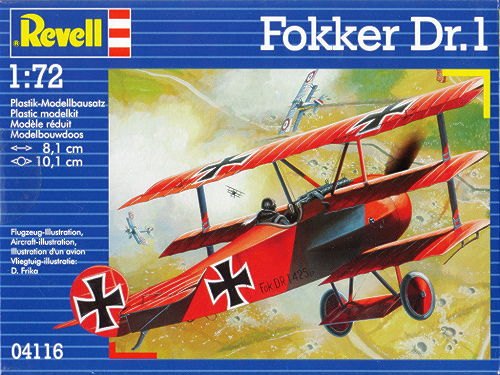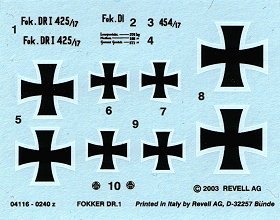
|
KIT: |
Revell 1/72 Fokker Dr.I |
|
KIT # |
04116 |
|
PRICE: |
€ 4.75 |
|
DECALS: |
Two options |
|
REVIEWER: |
Martin Sczepan |
|
NOTES: |
Not the older kit from the 60s |

|
HISTORY |
‘Heroism is an exception - and usually the result of a desperate situation’ - Th. Fontane, ‘Der Stechlin’
The Fokker Dreidecker is quite an astonishing aircraft. It surely was not the best fighter of WW I, it wasn’t even built in large numbers and also its impact on the fighting over the front lines was rather limited but if you ask people what they believe is the prototypical WW I fighter - most of them will name the Fokker.
What is the reason for this popularity? One of the reasons is probably that its design combines all the things we see as typical for that era - multi wing design, rotary engine, fabric covered wings and fuselage but still the plane has something distinctive. Something which makes you say ‘Fokker’ from whichever angle you see it. The other and probably more important is, that it was the mount of most of the great German WW I fighter pilots - just to name a few of them: Werner Voss, Ernst Udet, Lothar von Richthofen and the most famous of all - Manfred von Richthofen. In World war one the fighter aces were the media stars of their time.
The airplane as a weapon system was still new and the technical advances were fascinating for the people. In the trenches of the eastern and western fronts the industrialization of warfare with its machine guns, tanks and chemical attacks turned the soldiers into a indistinct gray mass and left no place for individual heroism. Soldiers were sacrificed just for the meaningless gain of some meters of charred soil. But in the skies over the front lines every thing seemed to be just as in the ‘good old times’ when a battle could be won just by the courageous action of one cavalry officer. But this made the fighter pilot also an instrument of propaganda. If all was quiet on the western front there were still the news about the great success of the fighter aces to make people believe that Germany was still on its way to victory and so the myth of the ‘knights of the sky’ was born. And like Siegfrieds sword Baldung the weapon of the new hero - the Fokker triplane became a legend of its own.
The plane itself was the result of Fokker’s attempts to get back into business after the successful E-series fighters were replaced with Albatros and Pfalz designs in the German air service. Instead of evolution Fokker and his design team under Reinhold Platz opted for revolutionary design changes - wings with thick profile and internal cantilever structure, streamlining and minimal amount of external bracing wires. It’s still debated where the ideas originated, probably they were a result of Fokkers cooperation with Hugo Junkers. The first prototypes were V1 to V3 were far ahead of their time but only partially successful. But then - through his good contacts with the German fighter pilots Fokker realized that the next plane required by the German Idflieg would be a triplane. The appearance of the Sopwith triplane in February 1917 made a great impression on the German pilots. It outclassed the Albatros D III - the German standard fighter of the time. And - as with the decision to turn the Abatros fighter into a sesquiplane before German command would go the ‘copy the design of your enemies’ route.
But instead of just building a copy of the Sopwith Triplane, Fokker built something new and original. When Idflieg called for designs in July 1917, Fokker had his triplane design - the prototypes V4 and V5 - ready for the fighter tests. The tests were successful and a small number of planes were ordered into production. The first two pre production machines - designated F 1 went to Werner Voss and Manfred von Richthofen for front-line evaluation. Voss and Richthofen were very successful with the new plane and could score several victories. So with some small changes (modified horizontal tail plane, skids under the outer wings) the plane went into mass production under the new designation Dr. I.
Nevertheless the use of the triplane was restricted to a rather small but very selected part of the German fighter units. Only 14 out of the 80 Jastas were equipped with the plane in significant numbers. But most of these were elite units. The Fokker Dreidecker was a demanding plane to fly but in the hands of an experienced and skilled pilot it could be a formidable weapon even if it was somewhat under powered with its 110 hp Oberursel engine. So some pilots kept their triplanes for a long time. Even in Summer 1918 the type could still be found in front line units and one German ace - Joseph Jacobs still flew his triplane in October 1918. Nevertheless the plane was obsolete and outclassed by its allied counterparts from the beginning of 1918. But since at this point no better German design was available the type had to stay in service until it could be replaced by more advanced types in spring 1918.
|
THE KIT |

Finally Revell's policy of replacing aged kits with new ones from molds made with modern technology and with the level of quality most modelers expect these days has reached their line of WW I kits.
The kit comes in one of those side opening boxes typical for Revell. You get two sprues in bright red containing 37 parts. Molding is crisp and almost flash free. Not surprising for a WW I airplane kit there is not much in the way of panel lines but the few lines which are present are of the recessed variety. The level of detail is exceptional. You get a fully furnished cockpit with structured side walls (including steel frame detail, plywood formers and various control elements), floor, rear bulkhead, seat, control column and ammo box. The rotary engine is a two part affair; the intake manifold comes as separate part.
Each of the three wings comes as a single piece with the center section of the middle wing forming the front fuselage upper decking. The ribbing detail on the wing upper sides looks somewhat heavy but under some coats of paint this will disappear. The treatment of the wing under sides with its ‘negative ribbing effect’ is somewhat reminiscent to the Dragon/DML 1/48 scale kit. Whether this is correct or not can be debated since photographic evidence seems inconclusive. Control horns on the ailerons and control surfaces are molded on. The tail planes are thin and here the fabric effect is more restrained.
Struts and small parts are really delicate. You
get really nice representations of the machine guns and even the prop -
usually one of the weak spots in most new 1:72 scale Revell kits - looks
good. The outer wing struts are given as one part units which are
inserted into rectangular openings in the middle wing. As an additional
part - not used for the two paint schemes in the kit - the additional
landing gear bracing strut found on some Dr. I is provided.
The instruction sheet is typical Revell, broken down into 18 steps. Additional small drawings help with the alignment of the parts and also some instruction for rigging is given.
Two decal options are supplied: Manfred von Richthofens all red 425/17 (what else) as it appeared in March 1918 before replacing the ‘Iron cross’ style national insignia with the ‘Balkenkreuz’ version and Lothar von Richthofens 454/17 also March 1918 with red engine cowling, struts and wheel disks and yellow upper wing and rear fuselage/tail. It would have been nice to have a paint scheme with ‘Balkenkreuz’ style national insignia but maybe Revell will address this with a later reissue. You also get some stencils in the form of serial numbers, weight table and prop labels. The quality of the decals is typical modern style Revell - good alignment, satin sheen, high resolution.
|
CONCLUSIONS |
This is a nice little kit which in the box looks like a winner. There are other modern Dr. I kits on the market in this scale but it seems that the Revell kit can easily compete with the Eduard and Roden offerings. The price at least is unbeatable - so if you want to build a whole ‘Jasta’ - this kit is the way to go...
Review kit courtesy of me and my wallet...
|
REFERENCES |
There is surely more but that’s what I used:
N. Franks, G. vanWyngarden: ‘Fokker Dr I aces of World War 1’, Osprey Aircraft of the Aces No 40
P. Leaman: ‘Fokker Aircraft of World War One’, The Crowood Press, 2001
H. J. Nowarra: ‘Fokker Dr. I in action’, ‘in action’ series No 98, Squadron/Signal Publications
If you would like your product reviewed fairly and quickly by a site that has nearly 250,000 visitors a month, please contact me or see other details in the Note to Contributors.